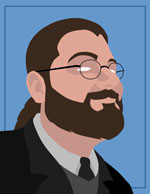This afternoon a very cool thing happened – my Twitter account was friended by the Twitter account for the University of Minnesota Press. Now, to a forward-thinking academic like me, this is not only very cool, it’s incredibly cool – and for multiple reasons.
First, the fact that they friended me leaves me with a sense of “They like me! They really like me!” Brands, bands and individuals that people already adore could foster in their fans a sense of validation by reaching out to their profiles first, before the fans themselves can find them.
Second, by following their Twitter account I can be delivered short, concise ads that I’d actually want – companies like the Criterion Collection could easily provide new announcement tweets to cinephiles like me, or – better yet – sub-brands like Vertigo Comics or creators. We’ve already seen Warren Ellis set himself up with a Twitter feed and he’s got over six thousand followers on Twitter already. Call them ads for the Brand Called You, call them fan service, or just call them connecting with six thousand likeminded souls, the impact is the same.
Third, by showing me who else follows this Twitter account (and who else it’s following), I can find other interesting connections. This same thinking holds true for other social networks as well, of course, but Twitter strikes me as particularly interesting for this sort of behavior in part because of the decision one can make to switch notifications on and off.
I wouldn’t be at all surprised to see Twitter launch grouping tools for its users shortly, so that I could divide the folks I follow into friends and corporate entities, or levels to which I tweet in a model similar to LiveJournal’s friendslocking mode. For such a simple idea, Twitter has certainly proven itself to be fertile ground for emergent complexity – and I suspect that’s where the business models lie. Twitter Pro for users who want to add friendslocking-style functionality, or a Twitter Corporate for businesses like the Minnesota Press who want to use Twitter as an ad delivery system.
Granted, one of the charming elements of businesses like The Minnesota Press on Twitter is the idea that there’s an actual warm body writing those tweets out there somewhere; Twitter is such a still-indie enterprise that it still conveys, to me at least, a sense of personal connection with those whom I’m following. However, given the number of spam follow notifications I receive, I’m not sure that will stay that way much longer. It’s this hat trick of corporate tweeting, a primed space for a tiered Pro package and the emergence of Twitter as a spam delivery system that makes me suspect that Twitter is right at the tipping point of some form of major reinvention.
We’ll see what happens. Follow me at http://www.twitter.com/geoffreylong and, for a low, low price, you’ll know when I do…!
Update: I should add that the University of Minnesota Press isn’t alone in this practice. Other wonderfully-geeky lit-tweeters include Penguin Books, The New York Times Arts, The New York Times Books, The Wall Street Journal, the awesome Publishing Talk, Yale Press (which desperately needs to learn the fine art of the tinyURL), Harper’s, The New Yorker, Norton Fiction, Little, Brown, and Grand Central Publishing. Brilliant stuff!

Storyteller, scholar, consultant. Loving son, husband and father. Kindhearted mischief-maker.
I'm the Director of the Games and Simulation program at Miami University in Ohio, where I am also an Assistant Professor in the College of Creative Arts' Emerging Technology in Business and Design department. I'm also the director of Miami's Worldbuilding and Narrative Design Research Laboratory (WNDRLab). I have a Master's in Comparative Media Studies from MIT and a PhD in Media Arts and Practices from the University of Southern California.
In past lives I've been the lead Narrative Producer for Microsoft Studios and cofounder of its Narrative Design team, working on projects like Hololens, Quantum Break and new IP incubation; in a "future of media" think tank for Microsoft's CXO/CTO and its Chief Software Architect; the Creative Director for the University of Southern California's World Building Media Lab and the Technical Director, Creative Director and a Research Fellow for USC's Annenberg Innovation Lab; a Visiting Assistant Professor at Whittier College and director of its Whittier Other Worlds Laboratory (WOWLab); the Communications Director and a researcher for the Singapore-MIT GAMBIT Game Lab; a founding member of the Convergence Culture Consortium at MIT (now The Futures of Entertainment); a magazine editor; and a award-winning short film producer. more »
The opinions put forward in this blog are mine alone, and do not reflect the opinions of my employers.

